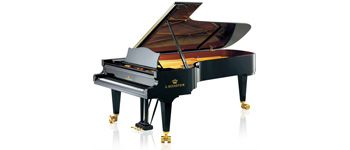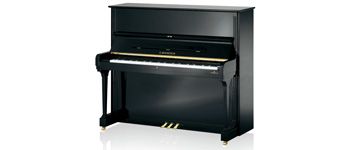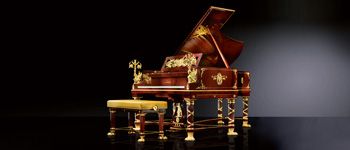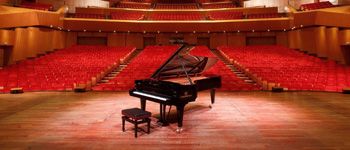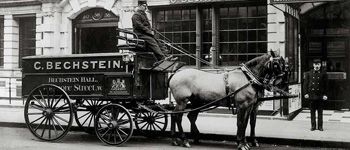Bechstein Tradition
Highest quality since 1853. Browse through the history of our company.
„I was simply very fortunate that God stood next to my workbench.“
Carl Bechstein, 1868
The patriarch
Berlin 1853. Friedrich Wilhelm Carl Bechstein, a twenty-seven-year-old instrument maker from Gotha, Thuringia, who is related to the writer Ludwig Bechstein famous for his compilation of traditional tales and legends, decides to live out his dream and make his vision reality: he founds his own business.
Berlin has not yet forgotten the troubles of the 1848 revolution. Frederic William IV, the king of Prussia nicknamed “the romanticist on the throne,” has not kept his promise: instead of granting a liberal constitution to his States, he has just introduced a tax-based three-class suffrage. His brother (who is to succeed him as Emperor William I) is nicknamed the “Cannon Prince” ever since he had hundreds of people shot to restore law and order during the 1849 Baden uprising. The Frankfurt parliament, which used to gather in the Saint Paul’s Church, has been dissolved and the hope of a unified Germany is vanishing: all German States, whether Hesse, Saxony or such Lilliputian principalities as Lippe-Detmold, are stagnating and their trading is slow due to the high customs duties they charge each other.
Such conditions lead many Germans to emigrate to America, either to escape political repression or simply to avoid starvation, and in the hope of finding better living conditions on the other side of the Atlantic Ocean. Among the celebrities who leave Germany but remain in Europe are Richard Wagner, who lives in exile in Zurich for political reasons, and the poet Heinrich Heine who, from his Parisian “mattress grave,” considers Germany as sinking into “A Winter’s Tale” as it becomes an archipelago of retrograde States.
Photo: Wikipedia
1850
The Gotha town hall, around 1850.
Historical context
Although the period is quite bleak, new ideas still arise and feed on the German spirit of enterprise. Friedrich Krupp runs modern steelworks in Essen, while August Borsig founds smelting works in Berlin. A new age begins, one of heavy industry, blast furnaces and steam railway engines. Nonetheless, the industrial development suffers under a mighty bureaucracy and the privileges of aristocracy that have not yet been abolished.
In 1854, Hanover finally joins the German Customs Union that Prussia initiated three decades earlier. This is real economical progress, but social progress does not keep pace: child labour remains legal as a Prussian law passed the same year merely raises the minimum age to twelve years.
The paintings by Adolph Menzel provide a good overview of the changes that occur in the mid-19th century. A broad-minded artist with a talent for rendering the world around him, Menzel mainly paints landscapes, portraits and genre paintings until the early 1850s. He also gives historic pictures and his favourite subject at that time is Frederic II, as we know from several portraits of that king: riding, playing the flute, together with his Court painter Antoine Pesne. In 1847, Menzel paints his two first works that feature social and contemporary subjects: a view of the Berlin-Potsdam railway and the portrait of two men entitled to suffrage. And in 1854, he gives a famous study that depicts Clara Schumann and the violinist Joseph Joachim. Not until the 1870s, however, will he devote himself to representing the industrial revolution, then painting one of his masterpieces: The Rolling Mill. To a certain extent, the non-representation of particular topics also reveals the spirit of a given time: for example, even though Menzel does not represent the barricades and fires that shook Berlin in 1849, his studies figuring a students’ torchlight procession can be understood as a discreet allusion to the riots.
All in all, 1853 is not the ideal year for founding a musical instrument business. We do not know exactly how many brave young craftsmen do the same as Carl Bechstein this year — but must bury their dreams under a mountain of debts shortly thereafter.
View in 1850 (Photo: Wikipedia)
1850
Carl Bechstein opens a factory near the Forum Fridericianum, in the heart of Berlin.
The rise of Berlin
Nonetheless, Berlin already enjoys a certain aura in the mid-1850s, even though it still is not the prestigious cultural metropolis that it would later become. Several decades ago, Romantic poets and philosophers formulated the visionary concept of “Athens on the Spree” as the cultural aspect of a political project: while Napoleon was remodelling Paris taking the Roman Empire as an example, Berlin was to become a new Athens; a capital city of arts, sciences, poetry and philosophy. As a reaction to the political and military hegemony of the French empire, the famous Prussian scientist Humboldt stated: “Science is power.” The idea remains valid in the mid-19th century, and still lives on today.
Moreover, Berlin is an obligatory station for numerous musicians as they travel from one European city to another. The Prussian well-to-do love music for a simple reason: in a period of political troubles, they seek refuge in music as it conveys a reassuring image, that of the Ancient Cythera. Thus it is not surprising that the Berlin bourgeoisie favours a musical instrument that is continuously being improved and offers unequalled learning possibilities: the piano.
Carl Bechstein arrives in Berlin in 1846 (or 1848, according to some sources) and starts working with Gottfried Perau, whose workshop is located on Hausvogteiplatz in the very centre of Berlin. Just like Kisting, Perau is famous in Berlin for his traditional pianos, but he is by no way a tinkerer in search of innovative solutions, like Theodor Stöcker, for example, whose pianos with downstriking action and articulated keyboard are still exceptional today.
Although Bechstein is entrusted with the management of the Perau workshop in the Autumn of 1848, he resigns shortly thereafter and travels to London the following summer, then to Paris where he improves his knowledge working with two great piano-makers: the ingenious Jean-Henri Pape, born in Sarstedt, Germany, and Jean-Georges Kriegelstein, an Alsatian whose pianos are exceptionally successful. Pape, who patented 120 inventions, impresses Bechstein with his creative potential, while Kriegelstein puts the young German in contact with contemporary business management and practices. Moreover, Kriegelstein’s success is based on a sensational innovation that he has marketed boldly since 1842: a compact but powerful upright piano of only 130 centimetres that offers well-balanced registers and constitutes a good investment.
Of course, the Érard brand is also famous when Carl Bechstein is in Paris. Among the innovations of the legendary company founder, Sébastien Érard, is the double escapement piano action still used — with certain improvements — in today’s grands. In the mid-19th century, every music aficionado knows that Franz Liszt favours the Érard pianos. We cannot ascertain whether Bechstein meets Pierre Érard, Sébastien’s nephew, but we know that the young German is perfectly aware of the brand’s worldwide significance. Until his death in 1855, Pierre Érard, who has been running the family business since 1831, is to strengthen his market position steadily: the Paris and London factories are producing nearly 2500 pianos a year; Paris’s Érard Hall is one of the city’s most famous concert venues; and the feasts given at the Château de la Muette, acquired by Sébastien in 1820, are attracting the capital’s high society. Does Érard’s success impress Carl Bechstein so deeply that he decides to become just as successful? We do not know exactly, of course, but the fact is that Bechstein is to supersede Érard as Europe’s main piano-maker in the decades to come.
What kind of man is Carl Bechstein, actually? By no means full of himself, he keeps no diary in his youth and will write no memoirs in his old age. Photos of him picture a self-confident man with an imposing stature. One of them (see page 9) shows him standing with his left elbow leaning on one of his uprights, with a large coat in the Romantic fashion draped over his broad shoulders. Such a fellow could not possibly remain unnoticed in a select Paris salon…
Upon his return to Berlin in 1852, Bechstein becomes manager of the Perau factory but as early as the next year, he departs for Paris again and works there just a few months as manager of the Kriegelstein factory. Why does he leave again? Maybe for the love of a certain Louise Döring, a young woman from Straussberg, Brandenburg, whom he would marry in 1856.
Photo: Wikipedia
The Brandenburg Gate, symbol of an up-and-coming cultural metropolis, around 1850
Carl Bechstein starts his own business
Back in Berlin for good now, he again works as the right hand of Perau, who allows him to build his own pianos starting 1 October 1853 in the upper storey of the company’s warehouse at Behrenstrasse 56. It is unlikely that Bechstein decides to settle down in Berlin because he knows that Perau would allow him to work on his own while managing the workshop. A better explanation for Bechstein starting his own production could be that his boss refused to implement in his pianos the innovations Bechstein learned of in Paris. Anyway, both men reach a gentlemen’s agreement and although Bechstein begins signing his name on pianos as soon as 1853, the official foundation of the company, as stated on official documents, is not until 1856.
A glance at a map of Berlin shows that Bechstein’s workshop is located at a strategic location in the Prussian capital. Behrenstrasse, also home to the Metropoltheater (renamed “Komische Oper” in 1846), runs parallel to Unter den Linden Boulevard and crosses both Charlottenstrasse and Friedrichstrasse — three streets where the city’s powerful and well-to-do are living. Moreover, Bechstein’s workshop is in the vicinity of the Opera, the Brandenburg Gate, Gendarmenmarkt (the square where the Lutter & Wegener pub is located that E.T.A. Hoffmann, the Romantic writer, used to frequently visit) and Leipziger Strasse (where are living the musician Felix Mendelssohn and rich culture-friendly people). We can therefore be fairly certain that Carl Bechstein did not decide by chance to locate his workshop in Behrenstrasse.
Courage, creativity and perseverance: three virtues of the Bechstein family
Various publications underscore the fact that some of his ancestors were also wilful and had a practical character. According to an article published in Gothaisches Tageblatt in 1926 on the occasion of the hundredth anniversary of Carl Bechstein’s birth, the company founder stems from peasants and craftsmen who had lived for centuries in various villages in Thuringia, in particular Laucha, Langenhain, Waltershausen and Ohrdruf. The article also states that several members of this family were talented musicians, which is not surprising as Thuringia has a long musical tradition. A certain Johann Matthäus Bechstein, who studied first theology, then natural sciences, established a forestry school in Waltershausen and later became director of the Dreissigacker/Meiningen Forest Academy. His nephew, Ludwig Bechstein, published a compilation of Thuringian tales that decisively contributed to popularisation of the German Middle Ages and was one of Richard Wagner’s sources of inspiration as he composed Tannhäuser. Appointed a librarian by the duke of Saxony-Meiningen and titled “Court Advisor,” which was a common form of sponsoring the fine arts in the 19th century, Ludwig Bechstein died in Meiningen in 1860.
Carl Bechstein's birth house in Gotha, Thuringia
Among his cousins were Carl Bechstein’s father, a hairdresser living in Laucha who worked hard, ran his own business… and played the spinet during his leisure time. He died in 1831 at the age of forty-two, leaving three children behind including Carl, the youngest at only five years old. Shortly after, his widow married Johann Michael Agthe, the cantor of Dietendorf’s church, who was strict with his own daughter and his new wife’s three children. Nonetheless, Carl’s father-in-law enabled the young boy to study the violin, the cello and the piano, prior to placing him in apprenticeship in Erfurt under the piano-maker Johann Gleitz in 1840. Emilie, Carl’s eldest sister, was already engaged to Gleitz and married him in 1844.
Although an alcoholic, Gleitz was not a bad craftsman, but Carl had to cope with his master’s bad temper during his four-year apprenticeship. Therefore, the company founder’s childhood and adolescence cannot be described as particularly happy. This probably explains why his contemporaries described him as someone particularly serious, but also amiable and debonair. Moreover, Carl Bechstein was thrifty, according to his own account that, leaving Dresden where he was working with Pleyl for Berlin, he walked all the way barefoot to save his shoes. Moreover, he took advantage of any opportunity to fulfil his education. For example, when he was directing the Perau factory he used his rare leisure time to learn French.

Provided with strong self-confidence and faith in his physical strength, the young Bechstein continues unwaveringly on the path he has chosen. As mentioned above, this way leads him from Berlin to London to Paris, then back to Berlin again where, in his small workshop on Behrenstrasse, he builds his first two pianos in 1853 within just nine months.
